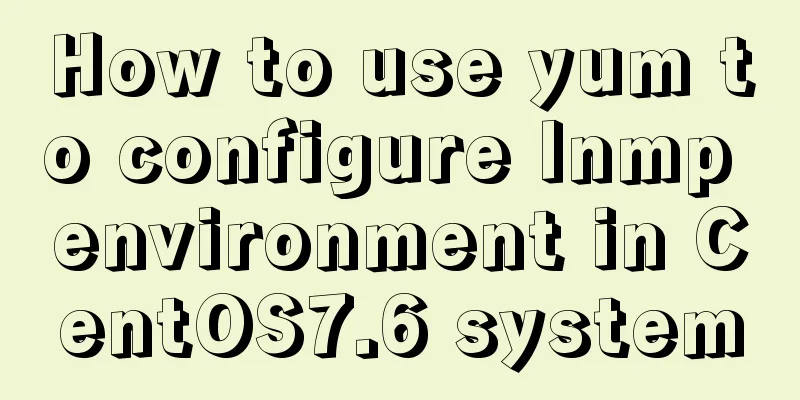How to use yum to configure lnmp environment in CentOS7.6 system

|
1. Installation version details Server: MariaDB Server version: 5.5.60-MariaDB MariaDB Server [root@ln-125 ~]# cat /etc/redhat-release CentOS Linux release 7.6.1810 (Core) [root@ln-125 ~]# nginx -v nginx version: nginx/1.14.2 [root@ln-125 ~]# php-fpm -v PHP 5.4.16 (fpm-fcgi) (built: Oct 30 2018 19:32:20) Copyright (c) 1997-2013 The PHP Group Zend Engine v2.4.0, Copyright (c) 1998-2013 Zend Technologies 2. Install Nginx service 1. Configure Nginx's yum source [root@ln-125 ~]# cat >> /etc/yum.repos.d/nginx.repo <<EOF [nginx] name=nginx-repo baseurl=http://nginx.org/packages/centos/$releasever/$basearch/ #releasever is the version number of Linux CentOS 7 gpgcheck=0 enabled=1 EOF 2. Install and add the auto-start function yum clean all; yum makecache ; yum list nginx; #You can now see the nginx installation package; yum install nginx; systemctl enable nginx ; systemctl start nginx If there are additional installation modules that need to be added, you can download the source code package from the official website according to the current Nginx version and incrementally compile the additional modules according to the current version. [root@ln-125 ~]# nginx -V nginx version: nginx/1.14.2 built by gcc 4.8.5 20150623 (Red Hat 4.8.5-28) (GCC) built with OpenSSL 1.0.2k-fips 26 Jan 2017 TLS SNI support enabled configure arguments: --prefix=/etc/nginx --sbin-path=/usr/sbin/nginx --modules-path=/usr/lib64/nginx/modules --conf-path=/etc/nginx/nginx.conf --error-log-path=/var/log/nginx/error.log --http-log-path=/var/log/nginx/access.log --pid-path=/var/run/nginx.pid --lock-path=/var/run/nginx.lock --http-client-body-temp-path=/var/cache/nginx/client_temp --http-proxy-temp-path=/var/cache/nginx/proxy_temp --http-fastcgi-temp-path=/var/cache/nginx/fastcgi_temp --http-uwsgi-temp-path=/var/cache/nginx/uwsgi_temp --http-scgi-temp-path=/var/cache/nginx/scgi_temp --user=nginx --group=nginx --with-compat --with-file-aio --with-threads --with-http_addition_module --with-http_auth_request_module --with-http_dav_module --with-http_flv_module --with-http_gunzip_module --with-http_gzip_static_module --with-http_mp4_module --with-http_random_index_module --with-http_realip_module --with-http_secure_link_module --with-http_slice_module --with-http_ssl_module --with-http_stub_status_module --with-http_sub_module --with-http_v2_module --with-mail --with-mail_ssl_module --with-stream --with-stream_realip_module --with-stream_ssl_module --with-stream_ssl_preread_module --with-cc-opt='-O2 -g -pipe -Wall -Wp,-D_FORTIFY_SOURCE=2 -fexceptions -fstack-protector-strong --param=ssp-buffer-size=4 -grecord-gcc-switches -m64 -mtune=generic -fPIC' --with-ld-opt='-Wl,-z,relro -Wl,-z,now -pie' 3. Install related PHP services Query the current PHP installation package Why install php-fpm here? Because php-fpm is the bridge between nginx and php, php-fpm (fast process management), the default process of php-fpm is 127.0.0.1:9000. After php and php-fpm are installed, you need to configure the nginx configuration file so that when it encounters a client php request, it will be forwarded to php-fpm (127.0.0.1:9000), and php-fpm will let php complete the parsing, and finally give it to nginx. 1. Installation yum install -y php php-fpm php-pear php-devel #httpd #httpd optional, parameter update php-pear is the php extension tool, after installation, you can use the pecl install command to install the php extension 2. Configure Nginx to support PHP files By default, Nginx processes html and htm files. You need to configure Nginx to support php.
vim /etc/nginx/conf.d/default.conf
...
location / {
root /usr/share/nginx/html; #Set the absolute path of the root directory index index.html index.htm index.php; #Match php files}
location ~ \.php$ { #Originally commented out, need to be enabled or copied root /usr/share/nginx/html; #Set the absolute path fastcgi_pass 127.0.0.1:9000;
fastcgi_index index.php;
fastcgi_param SCRIPT_FILENAME /scripts$fastcgi_script_name;
fastcgi_param SCRIPT_FILENAME $document_root$fastcgi_script_name; #Set the root directory to match include fastcgi_params;
}
...3. Set up Unix for PHP Sock communication (you can skip this step) The default configuration file uses the 9000 port for communication. For small single servers without load balancing, you can use unix sock communication to increase PHP response speed. touch /dev/shm/php-fpm-default.sock [root@ln-125 ~]# cat /etc/php-fpm.d/www.conf |grep -Ev '^;|^$' [www] listen = /dev/shm/php-fpm-default.sock listen.backlog = -1 listen.allowed_clients = 127.0.0.1 listen.owner = nobody listen.group = nobody listen.mode = 0666 user = nginx group = nginx . . . systemctl restart php-fpm.service systemctl enable php-fpm 4. Optimize configuration (optional) A) Modify the configuration of php.ini vim /etc/php.ini cgi.fix_pathinfo=1 #Remove the comments and enable PHP's pathinfo pseudo-static function. max_execution_time = 0 #The maximum time the script runs, 30 seconds by default max_input_time = 300 #The time the script can consume, 60 seconds by default memory_limit = 256M #The maximum memory consumed by the script, change the value according to your needs, 128M by default post_max_size = 100M #The maximum data for a single submission. This item does not limit the size of a single uploaded file, but limits the submission data of the entire form. The limit range includes all content submitted by the form. For example, when posting a post, the post title, content, attachments, etc. The default is 8M upload_max_filesize = 10M#The maximum permitted size of uploaded files, the default is 2M B) Modify the configuration of php-fpm vim /etc/php-fpm.d/www.conf Find the following two lines and uncomment listen.owner = nobody listen.group = nobody Find the following two lines and change their respective apache to nginx user = apache -> user = nginx group = apache -> group = nginx 4. Install mariadb database yum install -y mariadb mariadb-server #Startup automatically[root@ln-125 ~]# systemctl start mariadb.service [root@ln-125 ~]# systemctl enable mariadb.service #Initialize database configuration mysql_secure_installation #Configure default settings (root password login method, etc.) #Set the default character set to edit vim /etc/my.cnf [root@ln-125 ~]# grep -Ev '^#|^$' /etc/my.cnf [mysqld] datadir=/var/lib/mysql socket=/var/lib/mysql/mysql.sock symbolic-links=0 character-set-server = utf8 ##Set the default encoding [mysqld_safe] log-error=/var/log/mariadb/mariadb.log pid-file=/var/run/mariadb/mariadb.pid !includedir /etc/my.cnf.d systemctl restart mariadb.service 5. Testing cat >> /usr/share/nginx/html/index.php << EOF <?php echo phpinfo(); ?> EOF http://{domain name} If you see the test page, congratulations, you have completed the build. Summarize The above is the method of using yum to configure the lnmp environment under CentOS7.6 system introduced by the editor. I hope it will be helpful to everyone. If you have any questions, please leave me a message and the editor will reply to you in time. I would also like to thank everyone for their support of the 123WORDPRESS.COM website! You may also be interested in:
|
<<: Cross-database association query method in MySQL
>>: A set of code based on Vue-cli supports multiple projects
Recommend
Specific use of MySQL global locks and table-level locks
Table of contents Preface Global Lock Table lock ...
Vue implements video upload function
This article example shares the specific code of ...
How to implement Mysql switching data storage directory
How to implement Mysql switching data storage dir...
How to call a piece of HTML code together on multiple HTML pages
Method 1: Use script method: Create a common head...
A possible bug when MySQL executes the sum function on the window function
When using MySql's window function to collect...
Mysql practical exercises simple library management system
Table of contents 1. Sorting function 2. Prepare ...
Javascript Virtual DOM Detailed Explanation
Table of contents What is virtual dom? Why do we ...
MySQL 8.0.17 installation graphic tutorial
This article shares with you the MySQL 8.0.17 ins...
NodeJS realizes image text segmentation
This article shares the specific code of NodeJS t...
CSS makes the child container exceed the parent element (the child container floats in the parent container)
Preface Sometimes, we need a floating effect requ...
MySQL updates a field in a table to be equal to the value of a field in another table
As shown below: update table1 as z left join tabl...
Solution to the error message "java.sql.SQLException: Incorrect string value:'\xF0\x9F\x92\xA9\x0D\x0A...'" when storing emoticons in MySQL
Preface This article mainly introduces the soluti...
Analysis of the Principle and Function of MySQL Database Master-Slave Replication
Table of contents 1. Database master-slave classi...
MySQL5.7.03 Replacement of higher version to MySQL 5.7.17 Installation process and solutions to problems found
1. How to install? 1. [Run] -> [cmd] to open t...
Detailed explanation of MySQL database addition, deletion and modification operations
Inserting Data insert into table name (column nam...









